Is There a Flower That Blooms in All Seasons? Exploring Year-Round Blossoms
Imagine transforming your garden into a vibrant oasis that captivates every season. You might wonder if there’s a flower that can truly bloom all year long and keep your outdoor space alive. Good news: while no single flower blooms in every season everywhere, there are certain flowers that can thrive in multiple seasons depending on your climate.
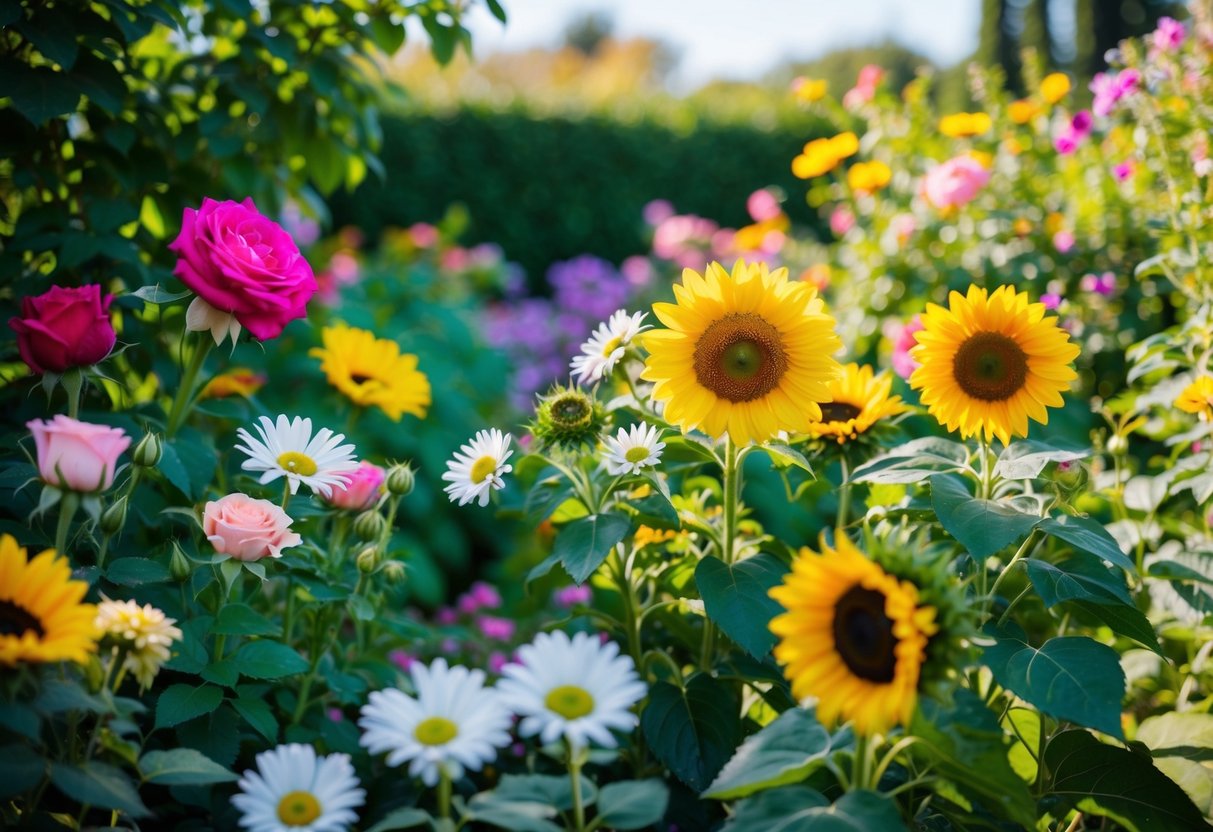
By choosing the right combination of perennial and annual flowers, you can enjoy a garden that’s always bursting with color. Asters and roses are popular choices since they have long blooming periods and add a delightful touch to any yard. You can explore more flowers that bloom through various seasons to keep your garden lively.
As you plan your garden, it’s helpful to think about the specific conditions where you live. Matching flowers to your local environment ensures a thriving and colorful display. With a little planning, your garden can become a sanctuary of beauty and color all year.
Understanding Flower Seasons
Knowing when your flowers will bloom helps you plan a garden that blooms year-round. This involves understanding the difference between annuals and perennials and how hardiness zones affect growth.
Annuals Versus Perennials
A key decision in gardening is choosing between annuals and perennials.
Annuals complete their life cycle in one growing season. These flowers grow, bloom, produce seeds, and die all in one year. You must replant annuals each year, but they offer vibrant color through the season. Popular annuals include petunias and marigolds.
Perennials, on the other hand, live for more than two years. They may not bloom all year, but they return each year. Some, like roses and lavender, can provide lovely blooms with proper care over time.
Your choice depends on how much time and effort you want to invest. Annuals offer instant, short-term color, while perennials give enduring beauty with less replanting each season.
The Role of Hardiness Zones
Gardeners often rely on hardiness zones to choose plants that will thrive locally.
A plant’s ability to grow well depends on its hardiness zone. These zones are defined by climate, especially the minimum temperatures in an area. The United States has USDA hardiness zones ranging from 1 (colder) to 13 (warmer).
Knowing your zone helps you select flowers that will survive winter temperatures. For example, if you live in zone 5, choose plants that can withstand cold, such as black-eyed susans. If you’re in a warmer area, zone 8 plants like asters might thrive.
Consider hardiness when selecting both your annuals and perennials to create a garden that blooms in all seasons.
Year-Round Blooming Flowers
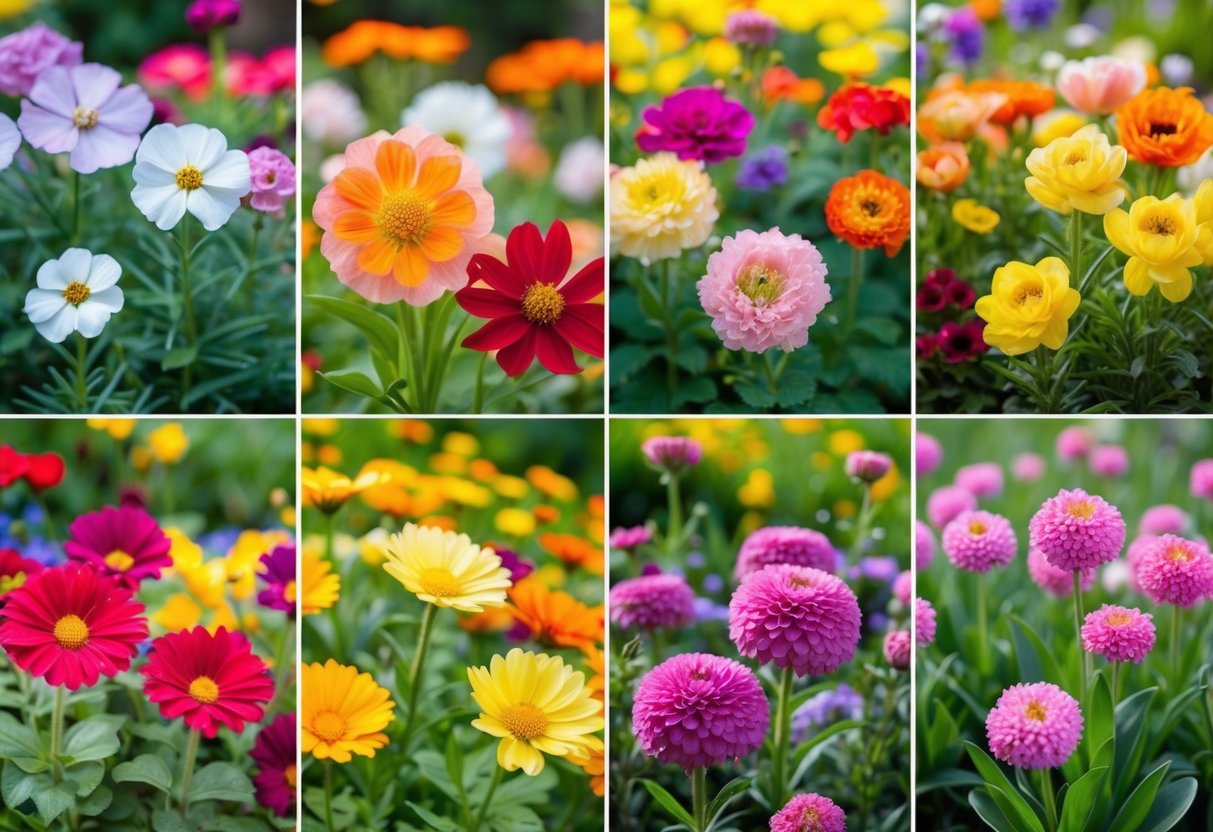
Certain flowers have the ability to bloom throughout the year, providing constant color and beauty to your garden. By choosing both perennial and annual varieties, you can enjoy these continuous blooms.
Perennial Plants That Bloom Across Seasons
Perennial plants are a great option if you want flowers that bloom all year. One popular choice is the crown of thorns. This plant blooms continuously with its unique appearance. If you prefer a bushy, vibrant look, consider gaura. It features tall, wavy stalks with pink or white flowers.
Another great option is the jungle geranium, which thrives in tropical climates like Florida. It’s made up of clusters of vibrant small flowers that add bold colors to your garden. These perennial options ensure your garden remains lively and colorful across seasons.
Choosing the Right Annual Flowers for Continuous Blooms
Annual flowers add a fresh and colorful touch to your garden year-round. Petunias are a popular choice for continuous blooms. They come in a wide range of colors and can brighten up any space. Zinnias are another wonderful option. They are easy to grow, low-maintenance, and offer a stunning array of vibrant colors.
Consider adding cosmos to your garden for a bold and colorful display. These flowers are fast-blooming and can thrive in various conditions. They provide a cheerful pop of color that can brighten any garden. By choosing the right annuals, you can maintain a lively garden throughout the year.
Caring for Multi-Season Blooms
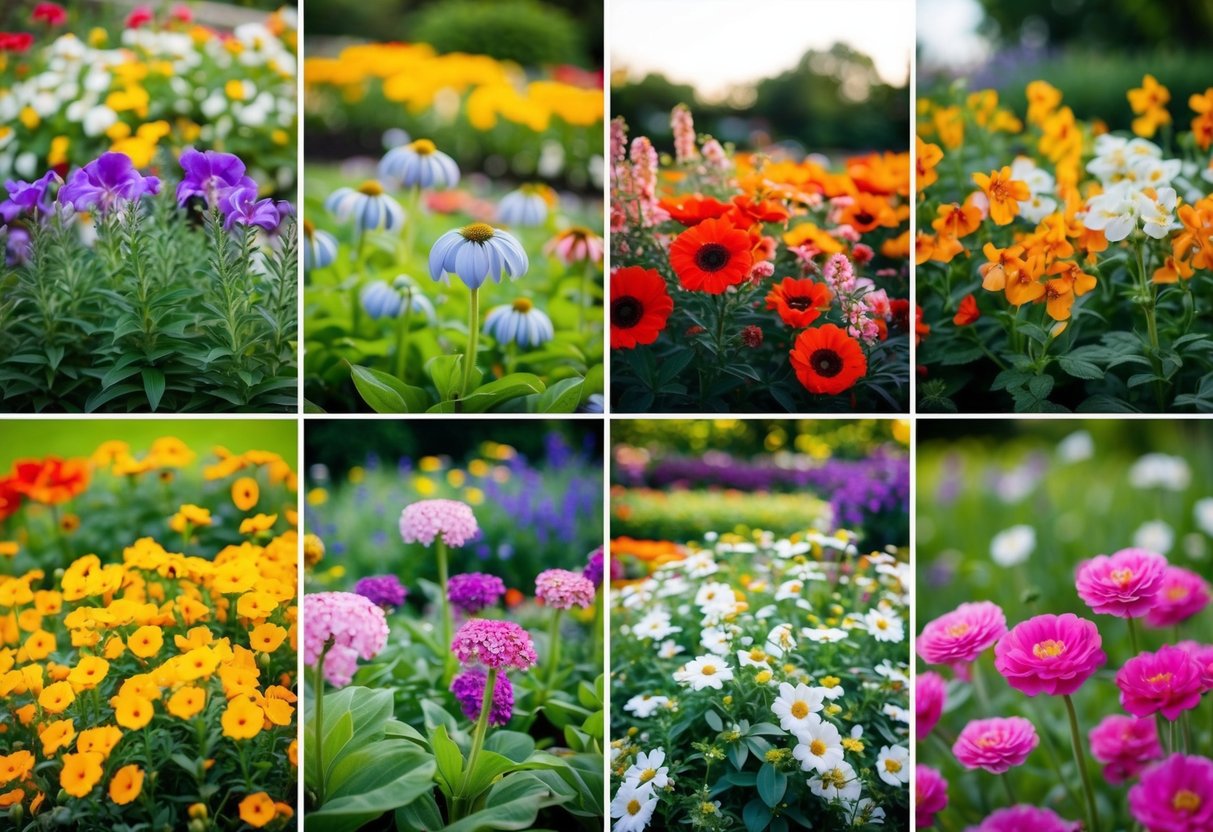
Keeping your garden vibrant throughout the year involves a mix of careful planning and mindful maintenance. By focusing on the needs of your plants and choosing hardy varieties, you can enjoy blooms in every season.
Maintaining Flower Beds Throughout the Year
Your flower beds need regular attention to stay healthy and beautiful. Start by scheduling seasonal tasks like weeding, pruning, and fertilizing. In spring, remove any dead plant material and apply a slow-release fertilizer to nourish new growth.
During summer, ensure your beds receive enough water, especially in hot weather. Mulching helps retain moisture and keeps weeds at bay. As fall approaches, cut back perennials like garden phlox and Shasta daisy to encourage strong root systems that will winter well. This preparation helps ensure vibrant growth next spring.
Winter might seem like a dormant time, but it’s essential to protect your flower beds. Cover more delicate plants or shrubs with protective layers such as burlap if frost is expected. Regularly check and clear any debris or snow that could smother your plants. This care ensures a healthy start when warm temperatures return.
Low-Maintenance Plants for the Avid Gardener
If you prefer a garden that flourishes without constant oversight, choose low-maintenance plants. Flowering shrubs like hydrangeas offer stunning blooms and need minimal intervention. They tolerate varying conditions and can be pruned back annually.
Consider hardy perennials such as garden phlox and Shasta daisy. These plants resist disease and pests, requiring less attention throughout the year. They also add color and life to your garden, reblooming with ease.
Planting perennials in clusters can also reduce required upkeep, as they naturally suppress weeds and retain moisture more effectively. When selecting plants, always consider your local climate and soil type to ensure they thrive with minimal care.
Popular Flowers and Their Blooming Periods
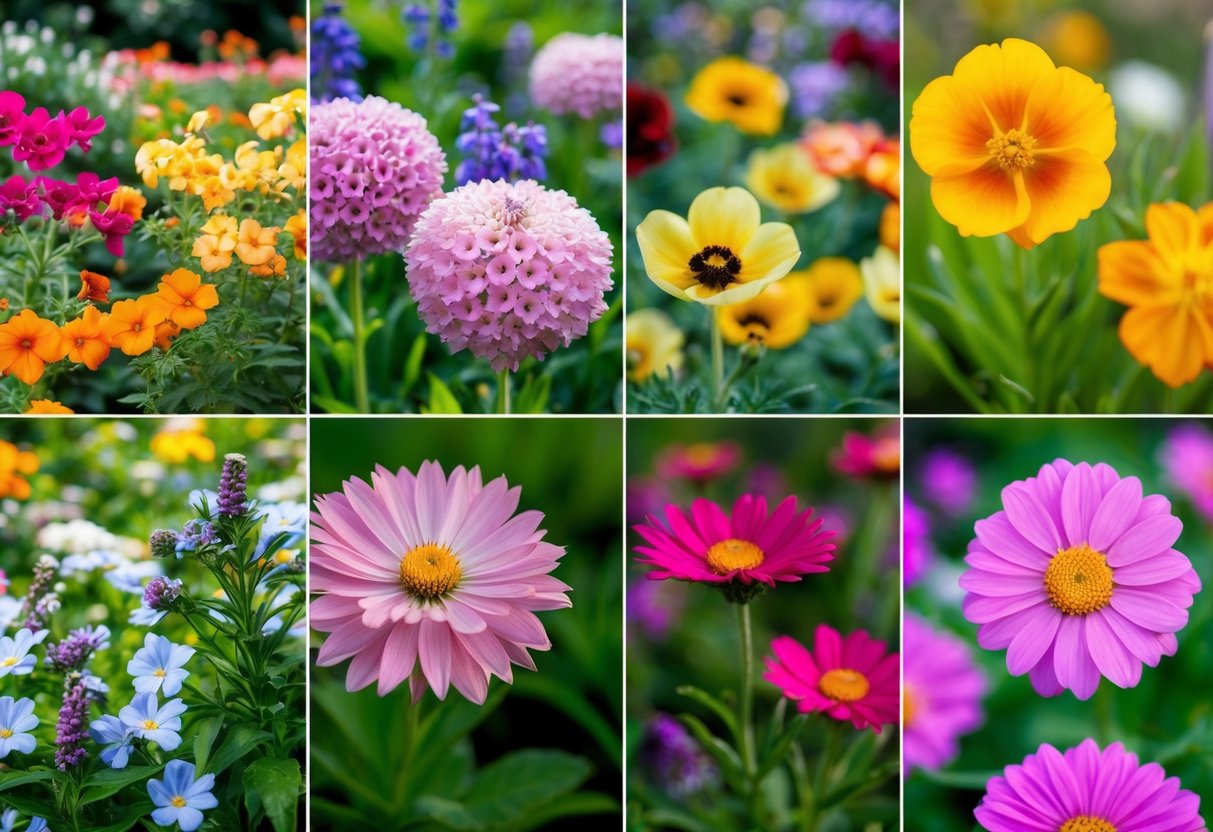
Many flowers can brighten your garden for long stretches of time. Shrubs and perennials, like coneflowers and English lavender, provide continuous blooms, while annuals such as lantana add vibrant colors.
Shrubs and Perennials with Long Blooming Periods
Coneflowers, also known as echinacea, are beloved for their colorful petals and extended blooming season. These hardy flowers offer beauty from early summer to the first frost, making them a favorite among gardeners. You might also appreciate roses, which often bloom multiple times throughout the growing season.
Lavender is another excellent choice for prolonged blooms. English lavender, especially, stands out. Its flowering period extends from late spring to early fall. If you wish for a tropical touch, the hibiscus is ideal. It showcases its vibrant flowers from spring through fall. Bougainvillea is another shrub that flowers for months, thriving in warmer climates.
Vibrant Annuals to Enhance Your Garden
Annual flowers can make your garden pop with color. Lantana is a standout, blooming from late spring right up until fall. Its cheerful clusters attract butterflies, adding more life to your garden. Lantana thrives in sunny spots, making it perfect for brightening corners.
Consider also planting lupines, with their tall, spiky blooms that can bring a whimsical feel. Though primarily perennials, in some climates, they are grown as annuals due to their adaptability. Cupflower is another annual favorite; its season extends from summer into fall, featuring a variety of colors like blue and purple. These annuals can refresh your garden scene seasonally with their bold hues.
Designing Your Garden for Year-Round Interest
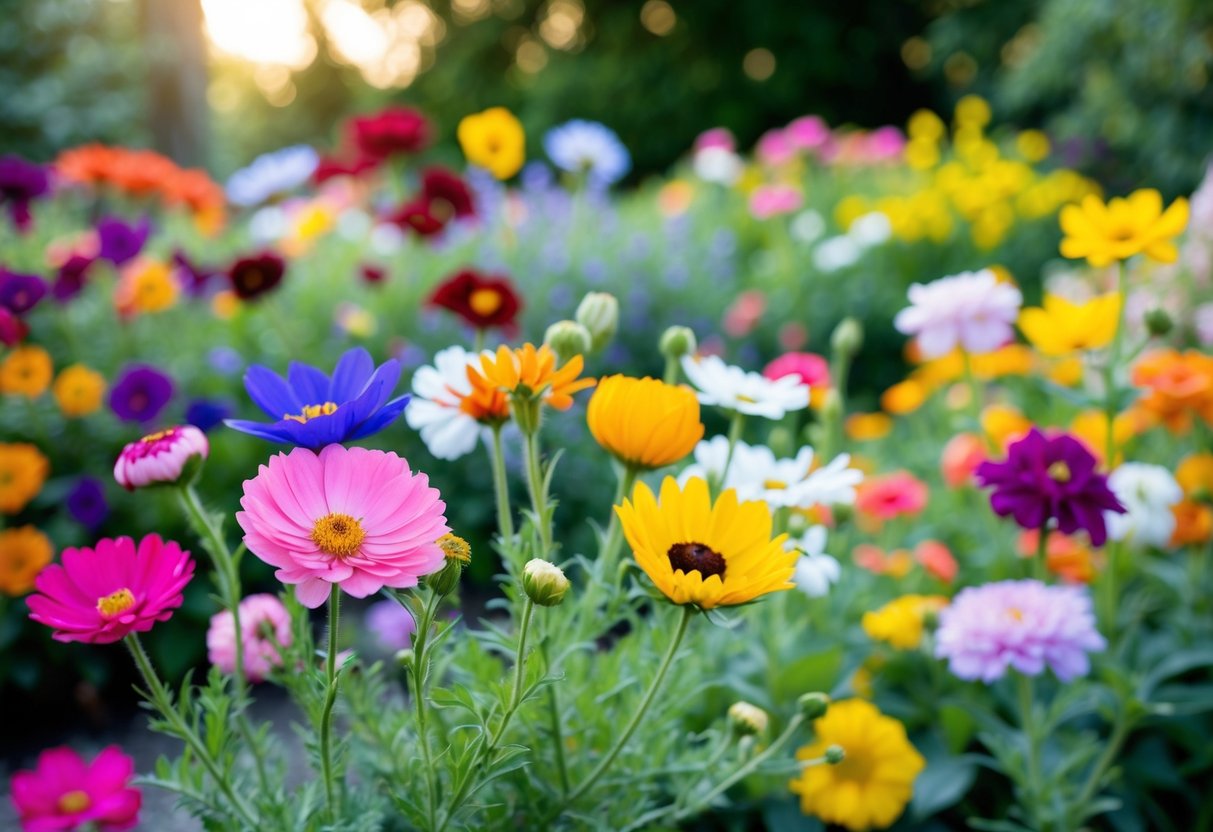
Creating a garden that maintains interest throughout the year involves using seasonal plants and strategic layout. You can enjoy colorful blooms and smart landscaping techniques to have continuous bursts of color.
Incorporating Colorful Blooms into Landscaping
To add a splash of color to your garden all year long, focus on selecting a mix of plants that bloom at different times. Flowering perennials are a great option because they can reappear each season. Chrysanthemums, for instance, offer vibrant fall colors, while springtime might bring tulips or daffodils. Visiting a garden center can help you find plants that match different seasons.
Another way to add interest is to use plants with year-round foliage. Evergreen shrubs provide a lovely backdrop against which your colorful blooms can stand out. Succulent plants can also add texture and interest even when flowers are not in bloom.
Incorporating container plants in your border gardens is an easy way to add instant color. You can move them around depending on the season to highlight different areas of your garden. By understanding the blooming cycles of your chosen plants, you’ll enjoy a continuous show of color.
Strategic Planting for Continuous Color
Strategic planting involves being intentional about where each plant goes for the best effect. Start by placing early-blooming perennials towards the front of your garden beds. Adding mid-season bloomers behind them ensures there are always fresh flowers on display.
Consider planting layers of different heights to create depth and visual interest. Taller plants, like hollyhocks, can provide a stunning backdrop. During the colder months, plan to add plants with winter interest, like hellebores, to keep your garden lively.
Grouping plants with similar water and sunlight needs helps them thrive together, requiring less maintenance. Plan your garden layout by mapping it out first, so you know exactly where each plant will go. By being thoughtful about plant selections and placements, you’ll create a garden that’s visually appealing year-round.







